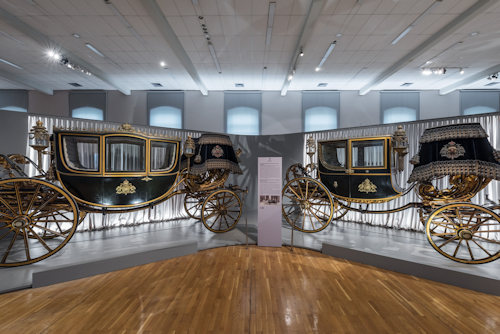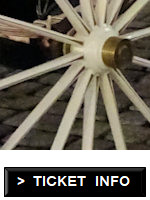To experience the extremes reached in Viennese court life, drop into the Imperial Carriage Museum (Wagenburg). No Emperor ever said “keep it simple” to the carriage builder.
- Habsburg vehicles in their ornate glory
- Includes an Empress Elisabeth exhibition
- Located in Vienna’s Schönbrunn complex
- What special exhibitions are on?
- Book Carriage Museum tickets* online
- See also:
- The Habsburgs for visitors
- Overview of Schönbrunn Palace
- History exhibitions in Vienna
Imperial carriages

(Parts of the exhibition © KHM-Museumsverband)
A giant hall houses what’s left of the Habsburg’s transport fleet; carriages, sleighs, and even a car.
Historical vehicles may not sound thrilling unless you have a special interest. But the Wagenburg actually gives you insight into court life, throws out some fascinating historical anecdotes, and shows you precisely what the words “ornate” and “lavish” really mean.
Just consider, for example, the miniature carriages used by the children of the Imperial family.
These vehicles include a particularly decorative one for the “King of Rome,” the name given to Napoleon’s son by his second wife, Marie Louise: a daughter of Habsburg Emperor Franz II/I.
Sheep pulled it.

(An Imperial carriage carrying Emperor Franz Joseph and Archduke Franz Ferdinand at the official procession of the 23rd Eucharistic Congress in Vienna on September 15th, 1912; photo published by the Österreichische Photographische Gesellschaft; Wien Museum Inv.-Nr. 42840/2; excerpt reproduced with permission under the terms of the CC0 licence)
You even encounter a leopard-skin sleigh (unfortunately, made from actual leopards, who probably needed the skins more than Prince Windisch-Graetz ever did).
Paintings reveal how the court would actually go on extravagant rides around the palace squares in sleighs built solely for that purpose.
Seeing artwork of the time holds a particular kind of fascination when you can also view the actual vehicles featured in those paintings.
The court equerry in charge of the state carriages even got his own state carriage.
I wonder if the gentleman in question was then responsible for his own vehicle. Anyway, I’m sure those peasants surviving on a turnip a day didn’t begrudge him his “company car”.
(Find tickets and experience options for the palace and zoo)
If you want to get particularly close to royal history, keep a look out for the following:
- The coach used by Empress Elisabeth when she first arrived in Vienna in 1854 prior to her marriage to the Emperor. Napoleon travelled in the same carriage when crowned King of Italy in 1805
- The black hearse carriage used in the funerals of Emperor Franz Joseph, Empress Elisabeth, and their son, Crown Prince Rudolph
- The 1914 motor car used to take the last Emperor into exile
And if you think the late-18th and 19th century carriages are ornate, they prove dull and lifeless when compared to the explosion of decoration on their Baroque predecessors.

(The 18th-century “Imperialwagen”; press photo © KHM-Museumsverband)
See, for example, the Imperial coach used to carry the likes of Emperor Joseph II (1741 – 1790) to various formal coronation ceremonies.
Somebody clearly ordered too much gold paint and the court motto of the time seemed to have been, “you can never have enough scrollwork”.
The Empress Elisabeth trail
They sometimes describe Empress Elisabeth (1837 -1898) as the Princess Diana of the 19th century, given their shared experiences.
As a notable bonus to your Imperial experience, a permanent exhibition within the Wagenburg guides you through the life and character of “Sisi” with the help of videos and some impressive items that once belonged to the Empress or the court.
You view, for example, Elisabeth’s original bridal train, a couple of dresses, toiletry items and more.
As such, the Wagenburg serves as an important stop on a self-guided Sisi tour of Vienna, particularly when combined with the Sisi Museum in Vienna’s city centre.
(For more locations in Vienna relative to Sisi, see this guide.)
Tickets, exhibitions & tips
Tickets are available from the source or online agencies.
(Booking service provided by Tiqets.com*, who I am an affiliate of)
Special exhibitions
Apart from the permanent Empress Elisabeth exhibition discussed above, the current schedule is:
- Victoria! (until July 6th, 2025): a small presentation that introduces you to the Victoria carriage used by Franz Joseph in his twilight years. In particular, learn about the restoration process for a vehicle that was long though lost to posterity
Some further tips:
- A Vienna Pass sightseeing pass (my review) includes one-time free access to the carriage museum
- The Wagenburg shop sells a small selection of souvenirs and books (also in English)
Since you’re exploring Imperial history, be sure to visit the wider Schönbrunn complex, too. In particular:
- Do the tour of the palace, which includes remarkable rooms bursting with history and introduces you to the life of the Imperial families (including Empress Elisabeth and Emperor Franz Joseph)
- From the Wagenburg, continue out west for a circular walk through the park that takes in the landscaped areas around the palm house and back to the patterned gardens behind the palace proper
Getting to the Wagenburg
See the main article on directions to Schönbrunn (easily reached from the centre on the U4 subway line). You’ll find the carriage museum in the grounds of the palace, a short walk due west of the main building.
Address: Schloß Schönbrunn, 1130 Vienna | Website
